
Mastering Nuance: The Indispensable Role of the Comparing with Adjectives Worksheet
In the intricate tapestry of language, adjectives serve as the vibrant threads that add color, detail, and specificity to our descriptions. They allow us to paint vivid pictures, convey precise emotions, and differentiate between countless nouns. However, merely using adjectives is not enough; true linguistic proficiency demands the ability to compare and contrast, to articulate subtle differences and emphasize significant distinctions. This is where the concept of degrees of comparison comes into play, transforming simple descriptions into nuanced observations. For both educators and learners, a well-crafted comparing with adjectives worksheet emerges as an indispensable tool in mastering this crucial grammatical skill.
The journey of understanding comparative and superlative adjectives is fundamental to achieving fluency and accuracy in English. It moves beyond simply stating "The dog is big" to expressing "The dog is bigger than the cat" or "The dog is the biggest animal in the park." This progression from positive to comparative to superlative degrees of comparison unlocks a new level of descriptive power, enabling speakers and writers to communicate with greater precision and impact.
The Foundation: Understanding Degrees of Comparison
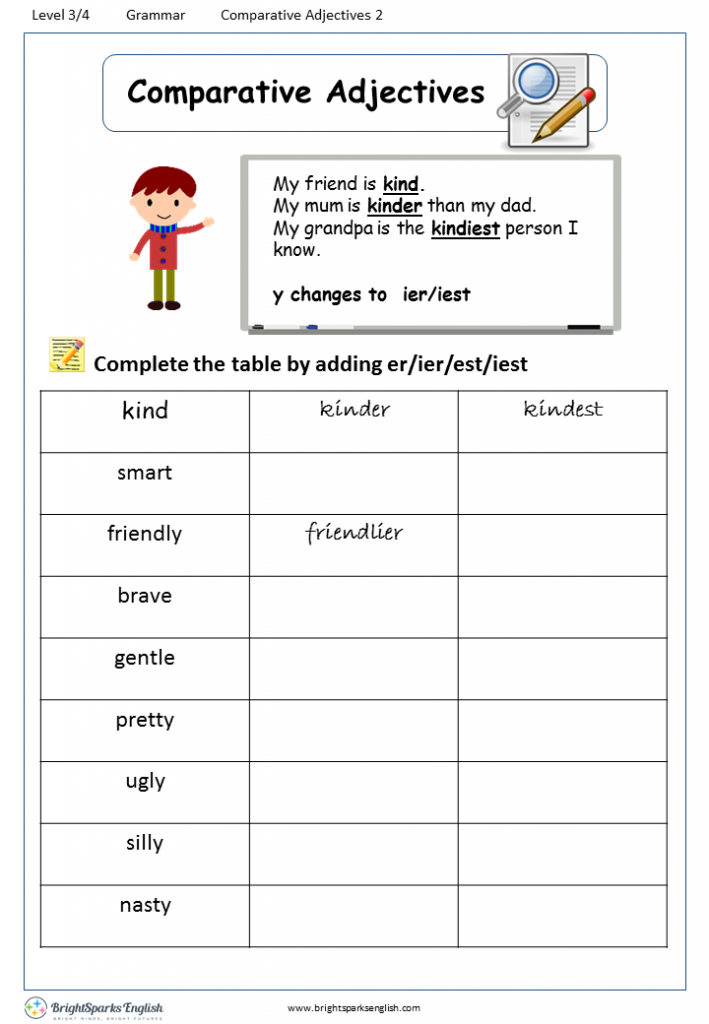
Before delving into the specifics of an effective comparing with adjectives worksheet, it’s essential to revisit the core concepts:
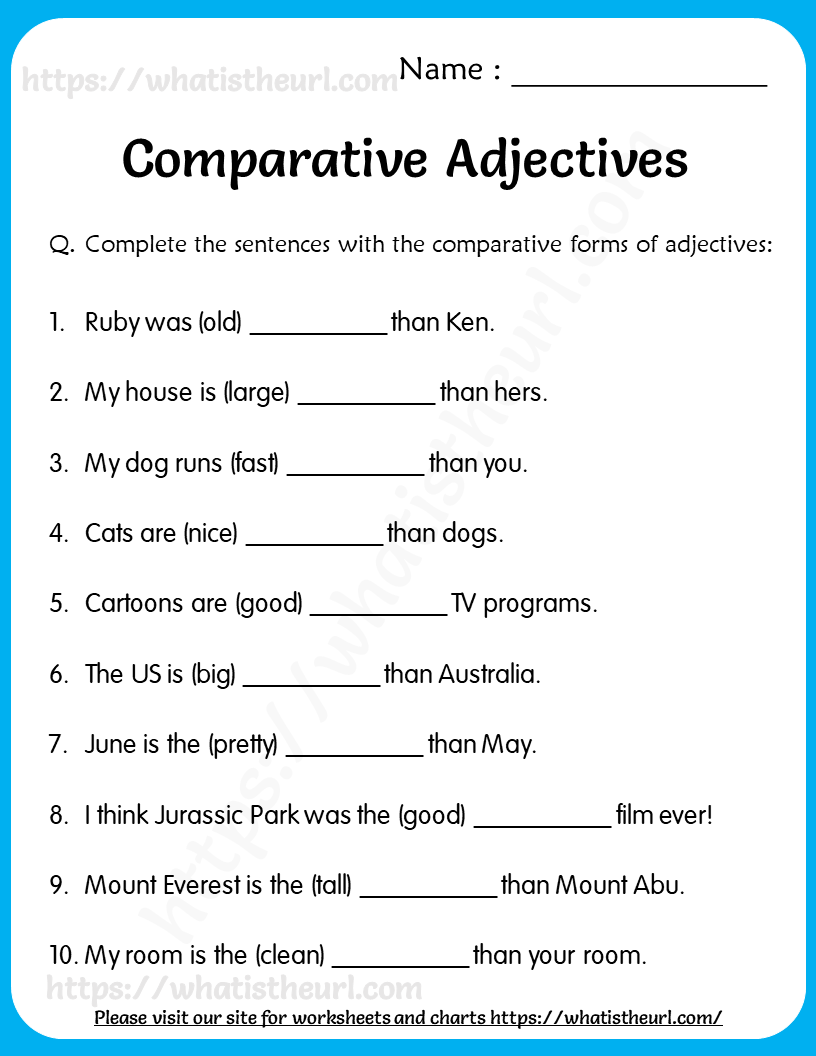
-

Positive Degree: This is the basic form of the adjective, used when describing a single noun without making a comparison.
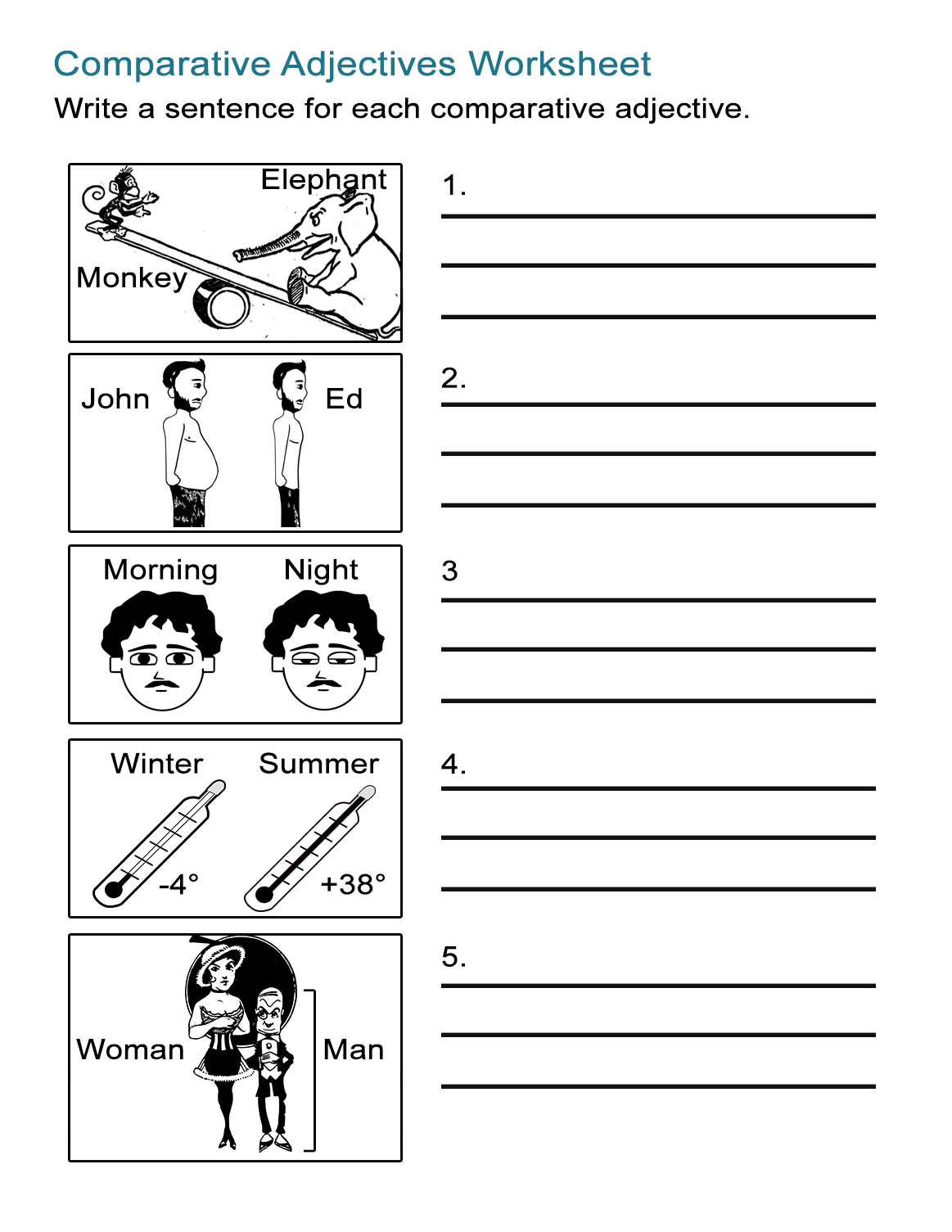
- Examples: tall, beautiful, fast, good, bad.
- Sentence: The house is old.
-
Comparative Degree: This form is used to compare two nouns, indicating which one possesses a quality to a greater or lesser extent than the other.
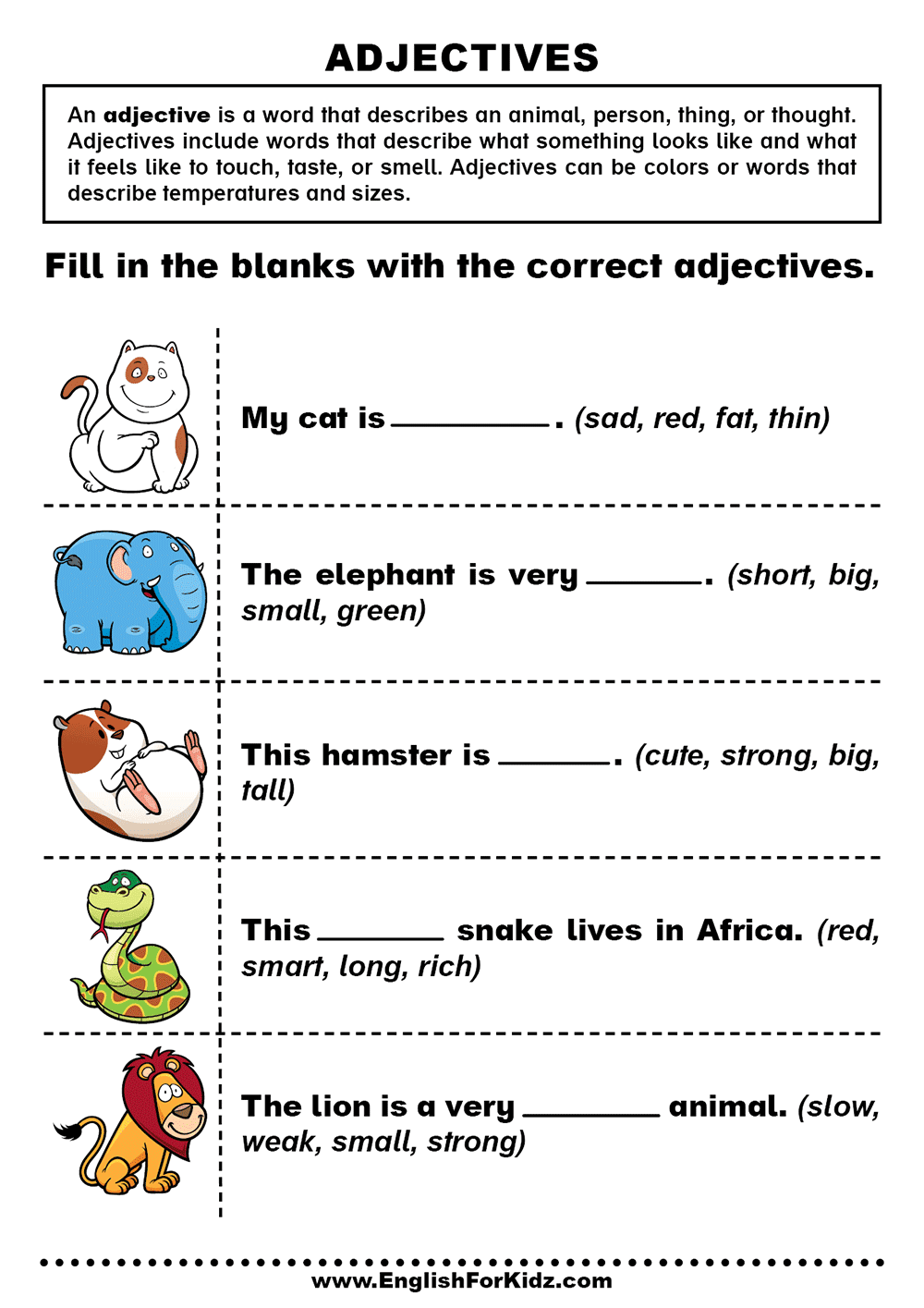
- Formation:

- For most one-syllable adjectives: add "-er" (e.g., tall -> taller, fast -> faster).
- For some two-syllable adjectives ending in -y: change -y to -i and add "-er" (e.g., happy -> happier, easy -> easier).
- For adjectives with two or more syllables: use "more" before the adjective (e.g., beautiful -> more beautiful, important -> more important).
- Irregular adjectives: These change completely (e.g., good -> better, bad -> worse, far -> farther/further).

- Key word: "than" is almost always used after the comparative adjective.
- Sentence: This house is older than that one.
- Formation:
-
Superlative Degree: This form is used to compare three or more nouns, indicating which one possesses a quality to the greatest or least extent among the group.
- Formation:
- For most one-syllable adjectives: add "-est" (e.g., tall -> tallest, fast -> fastest).
- For some two-syllable adjectives ending in -y: change -y to -i and add "-est" (e.g., happy -> happiest, easy -> easiest).
- For adjectives with two or more syllables: use "most" before the adjective (e.g., beautiful -> most beautiful, important -> most important).
- Irregular adjectives: (e.g., good -> best, bad -> worst, far -> farthest/furthest).
- Key word: "the" is almost always used before the superlative adjective.
- Sentence: This is the oldest house on the street.
- Formation:
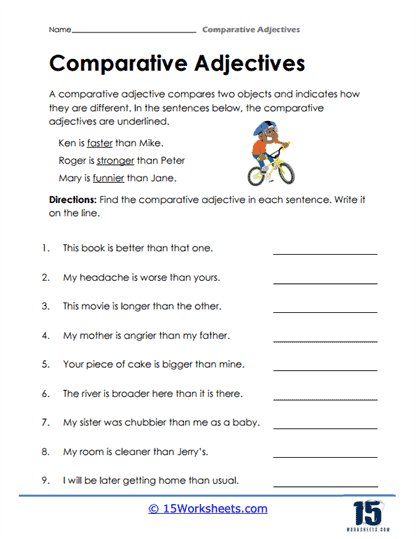

The complexity lies not just in memorizing the forms but in understanding the rules for their application, the exceptions, and the subtle nuances of meaning they convey. This is precisely where a structured and comprehensive comparing with adjectives worksheet proves its worth.
Why the Comparing with Adjectives Worksheet is Indispensable
A well-designed comparing with adjectives worksheet serves multiple pedagogical purposes, making it a cornerstone of effective grammar instruction:
- Reinforcement of Rules: Worksheets provide repeated exposure to the rules of forming comparative and superlative adjectives, helping students internalize patterns and exceptions. Through practice, the "er/est" and "more/most" rules become second nature.
- Application of Knowledge: Beyond rote memorization, worksheets require students to actively apply their understanding in various contexts, from simple fill-in-the-blanks to more complex sentence constructions. This application solidifies learning.
- Identification of Gaps: As students work through exercises, common errors (e.g., "more bigger," "goodest") become evident, highlighting areas where further instruction or practice is needed. For teachers, this provides valuable diagnostic information.
- Independent Practice: Worksheets offer a structured environment for independent learning, allowing students to work at their own pace and build confidence without constant teacher intervention.
- Foundation for Speaking and Writing: Mastery of comparative and superlative adjectives is crucial for articulate speech and sophisticated writing. Worksheets build the grammatical foundation necessary for students to express comparisons naturally and correctly in their spoken and written output.
- Structured Learning Progression: A good worksheet can guide students through increasing levels of difficulty, starting with basic forms and moving to irregulars, contextual use, and error correction.
Designing an Optimal Comparing with Adjectives Worksheet
Crafting an optimal comparing with adjectives worksheet requires careful consideration of various elements to ensure maximum learning efficacy:
- Clear and Concise Instructions: Ambiguous instructions can derail the learning process. Each section of the worksheet should have clear, easy-to-understand directions.
- Gradual Difficulty Progression: Start with the basics (positive to comparative, then positive to superlative) using common, regular adjectives. Gradually introduce irregular forms and then move to more complex sentence structures or contextual exercises.
- Variety of Exercise Types: Monotony can lead to disengagement. Incorporate diverse exercise formats to keep students interested and challenge different aspects of their understanding:
- Fill-in-the-Blanks: Provide sentences with blanks where students insert the correct comparative or superlative form of a given adjective.
- Example: My sister is (tall) __ than me.
- Sentence Transformation: Give a sentence in the positive degree and ask students to rewrite it in the comparative or superlative.
- Example: The blue car is fast. (Comparative) -> The blue car is __ than the red car.
- Multiple Choice: Present a sentence with a blank and provide several options for the correct comparative/superlative form.
- Error Correction: Provide sentences with common errors in adjective comparison and ask students to identify and correct them. This promotes critical thinking and reinforces correct usage.
- Example: He is more taller than his brother. (Correction: He is taller than his brother.)
- Picture-Based Comparisons: Show two or more images and ask students to write sentences comparing them using adjectives. This is excellent for visual learners and adds a creative element.
- Scenario-Based Writing Prompts: Present a short scenario or prompt (e.g., "Compare two different cities you’ve visited") and ask students to write a few sentences or a short paragraph using comparative and superlative adjectives. This moves beyond isolated sentences into contextual application.
- Matching Activities: Match positive forms to their corresponding comparative and superlative forms, especially useful for irregular adjectives.
- Fill-in-the-Blanks: Provide sentences with blanks where students insert the correct comparative or superlative form of a given adjective.
- Inclusion of Irregular Adjectives: These are often the trickiest for learners. Dedicate specific sections or exercises to reinforce the forms of "good/better/best," "bad/worse/worst," "far/farther/farthest," etc.
- Contextualization: Instead of isolated words, present adjectives within meaningful sentences or short paragraphs. This helps students understand how these forms function in natural language.
- Visual Appeal and Layout: A cluttered or poorly formatted worksheet can be intimidating. Use clear fonts, adequate spacing, and potentially some simple graphics to make the worksheet inviting and easy to navigate.
- Answer Key: Providing an answer key, especially for self-correction or peer-correction activities, is invaluable. It empowers students to take ownership of their learning and allows teachers to efficiently check understanding.
Integrating the Worksheet into the Lesson Plan
The effectiveness of a comparing with adjectives worksheet is amplified when integrated thoughtfully into a broader lesson plan:
- Pre-Worksheet Activities (Introduction & Explanation): Before distributing the worksheet, explicitly teach the rules for forming comparative and superlative adjectives. Use clear examples, visual aids (like charts), and interactive activities (e.g., asking students to compare objects in the classroom). Discuss the common exceptions and irregular forms.
- During Worksheet Activities (Practice & Monitoring):
- Individual Work: Allow students to complete sections independently, fostering self-reliance.
- Pair Work/Group Work: Encourage collaboration by having students complete parts of the worksheet together, discussing answers and explaining their reasoning. This promotes peer learning.
- Teacher Monitoring: Circulate around the classroom, offering help, clarifying instructions, and noting common errors that can be addressed later with the whole class.
- Post-Worksheet Activities (Review & Extension):
- Review Answers: Go over the answers as a class, explaining why certain forms are correct and addressing any persistent misconceptions.
- Address Common Errors: If many students made the same mistake, re-teach that specific rule or provide additional examples.
- Extension Activities:
- Speaking Practice: Engage students in debates ("Which is better: summer or winter?"), descriptive games ("Describe and compare your favorite animals"), or ‘compare-and-contrast’ discussions.
- Writing Practice: Assign short writing tasks, such as comparing two books, movies, or historical figures; writing product reviews; or creating advertisements that highlight superior qualities.
- Real-World Connections: Point out comparative and superlative adjectives in advertisements, news articles, or everyday conversations.
Common Pitfalls and How Worksheets Help
Students often stumble on specific aspects of comparative and superlative adjectives. A well-designed comparing with adjectives worksheet can specifically target these common pitfalls:
- Double Comparatives/Superlatives: The classic "more bigger" or "most biggest." Worksheets with error correction exercises are excellent for addressing this.
- Incorrect Rule Application: Applying "-er/-est" to long adjectives or "more/most" to short ones (e.g., "beautifulest," "more tall"). Varied practice helps solidify the correct rule for different adjective lengths.
- Overlooking Irregular Forms: Treating "good" as "gooder/goodest." Dedicated sections for irregulars are crucial.
- Missing "than" or "the": Forgetting to include "than" in comparative sentences or "the" before superlative adjectives. Fill-in-the-blank exercises can specifically prompt for these articles/conjunctions.
- Confusion with Adverbs: Sometimes students confuse adjectives with adverbs, applying comparative rules incorrectly. While not the primary focus, a worksheet on adjectives can indirectly help reinforce the distinction.
Conclusion
In the journey towards linguistic mastery, the ability to compare and contrast effectively is paramount. It allows for precision, nuance, and vividness in communication. The comparing with adjectives worksheet stands out as an indispensable resource in this endeavor, providing structured practice, reinforcing rules, and identifying areas for improvement. From basic sentence completion to creative writing prompts, these worksheets offer a versatile and effective pathway for students to internalize the complex yet vital rules of adjective comparison. By thoughtfully designing and strategically integrating them into lesson plans, educators can empower their students to move beyond simple descriptions and embrace the rich, expressive power of comparative and superlative language, truly mastering the art of describing and differentiating the world around them.
